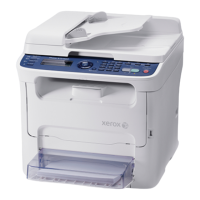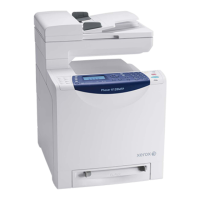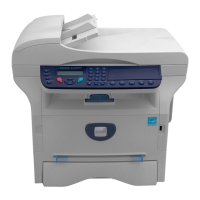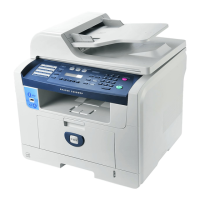2-98 Phaser 6180MFP Multifunction Printer Service Manual
Theory of Operation
Scanner
The Scanner consists of a lamp (fluorescent lamp, etc.) that illuminates the
original document with uniform light and a Charged Coupled Device (CCD),
which reads the light reflected from the image.
A CCD is a light-receiving element that produces an electrical signal in
response to light. In the case of a Fax, a number of CCDs are arranged in a
line.
The white areas of the original document reflect the light from the lamp. The
black areas reflect no light. The CCDs read the light reflected from the
original, outputting sequentially to the control circuit, which areas are white
and which black as binary data (1/0 digital data: 1 bit).
To scan the original, the CCD device must be shifted a distance of one line
after each line is scanned. When the original is scanned on the document
glass (as for a flatbed scanner), the CCD unit is moved with respect to the
original. In the case of a Fax equipped with the ADF, scanning via the ADF is
performed by moving the original with the CCD fixed at one position. This is
called Constant Velocity Transport (CVT).
During scanning, the finer the grid into which the original is divided, the
greater scanning precision of the original image. For a G3 Fax (normal mode:
G3 Normal), scanning is performed at the resolution of 8 divisions per
millimeter (200 dpi) in the horizontal direction and 3.85 divisions per millimeter
in the vertical direction. This means that the 200 dpi in-line CCD unit is shifted
approximately four times per millimeter in the vertical direction. For an A4
original, the data amounts to approximately two million pixels. In the high-
quality mode (G3 Fine), scanning resolution is 8 divisions per millimeter in the
horizontal direction and 7.7 divisions per millimeter in the vertical direction,
where the data amounts to approximately four million pixels. As resolution
increases, the amount of data also increases, lengthening the transmission
time.
Control Circuit
The Control Circuit executes scanning of image data by controlling the image
scanner. A line of CCDs scans the original image one line at a time. When
scanning of one horizontal line is completed, the next line below is scanned.
As this continues, the original is scanned from end to end one line at a time
and converted to digital data as black-and-white information.
Because this image data is a set of digital signals, it cannot be transmitted
using an analog telephone line; it must be subjected to DA conversion
(modulation). On the other hand, the receiving Fax machine must perform AD
conversion to restore the incoming digital data to analog data.
DA conversion, analog signal transmission, analog signal reception, and AD
conversion are all performed by a modem (modulator/demodulator) in the
control circuit. A modem consists of a Network Control Unit (NCU) for
connecting to the telephone line and an A/D conversion unit for performing DA
and AD conversions.
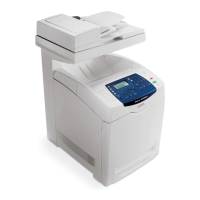
